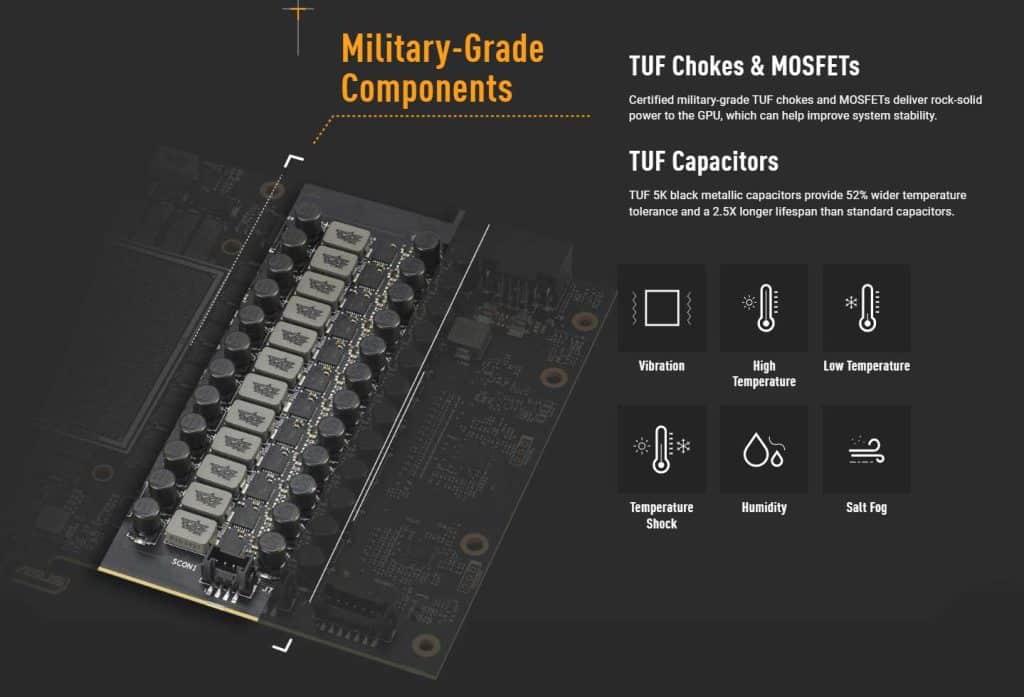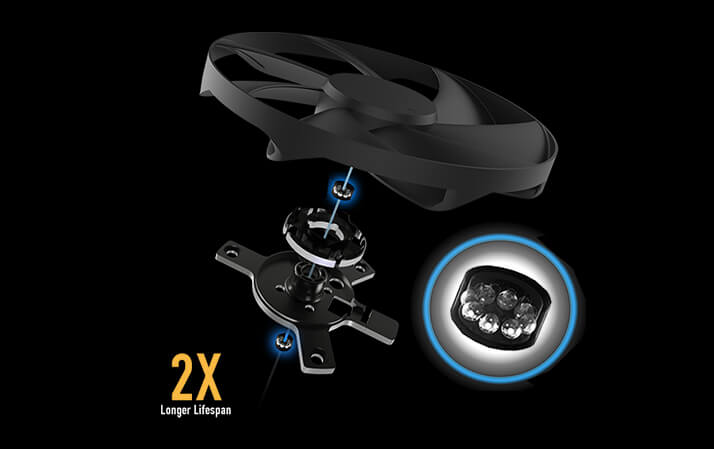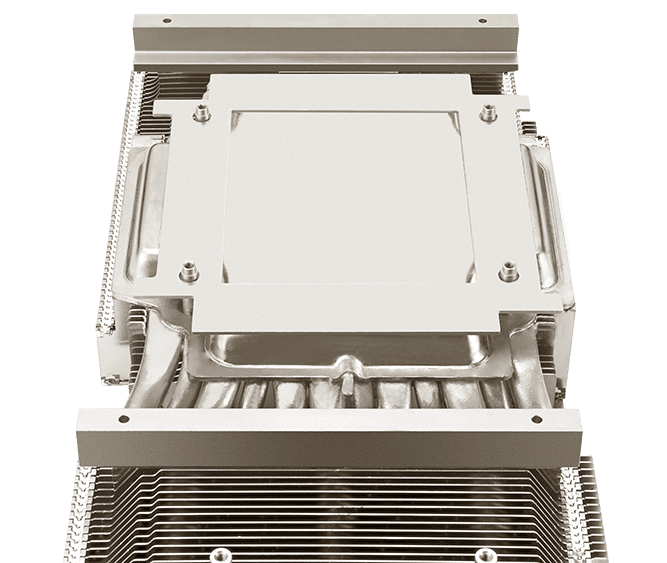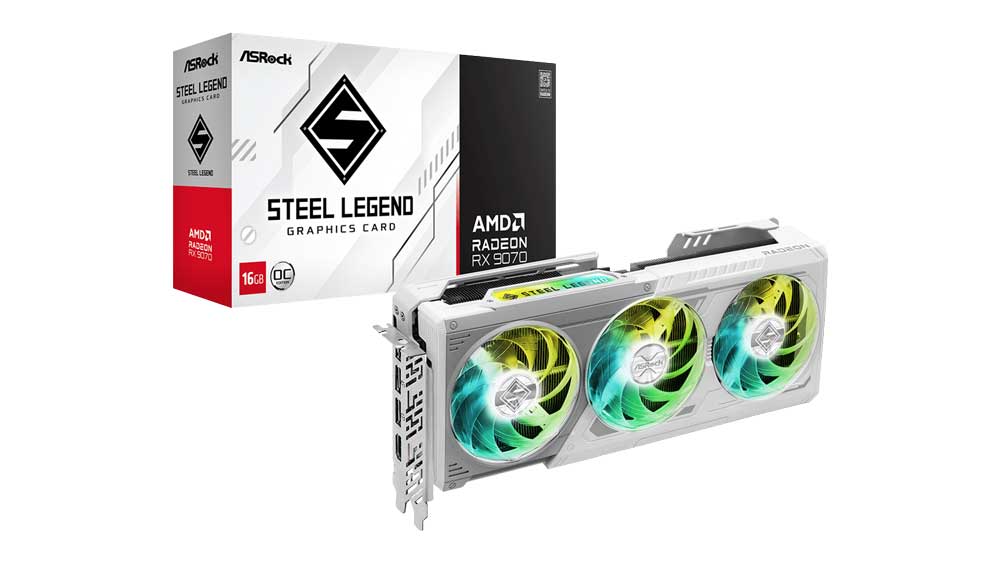Part Analysis
Because I bought this card out of my own money and without sponsorships, I won’t perform a part analysis since I need to keep it under warranty if anything happens. Given the problems reported with 12V-2×6 headers on RTX 5090 cards, I think this is the best way. I will use Asus photos, videos, and information on this page to describe what is going on below the hood.
Asus states that it uses military-grade chokes, FETs and capacitors in this product, to ensure high reliability and tolerance to abuse.
Asus calls it a phase-change thermal pad and uses it to increase the thermal conductivity between the GPU and the heatsink. Better GPU thermal conductivity for a prolonged time means less trouble for users, which is crucial for a GPU with a TDP that can exceed 600W!
As it should be the case on all high-end products, the PCB has a protective coating to withstand moisture, dust, or debris.
While most brands and manufacturers prefer FDB fans since they can combine increased lifetime, under normal operating conditions, with low noise especially at lower speeds, Asus insists on double-ball bearing fans. While DBB fans can have bearing noise at lower speeds, they are way more tolerant to high operating temperatures than FDB ones, and quality DBB fans have increased production cost. Nonetheless, we talk about a product with a $2000 MSRP and a way higher street price.
The two outer fans spin counterclockwise to reduce turbulence and noise. All three fans stop when the GPU’s temperature is below 50°C, and restart above 55°C with a speed curve that follows the GPU’s temperature.
The massive heatsink has twelve heatpipes and a vapor chamber. It has to deal with >600W of power, so it makes sense to make it as easy as possible.
- Prologue & Technical specifications
- NVIDIA’s Key Technologies
- Box & Contents
- Part Analysis
- Specifications Comparison
- Test System
- Game Benchmark Details
- Raster Performance
- RT Performance
- RT Performance + DLSS/FSR Balanced
- Raytracing Performance + DLSS/FSR Balanced + FG
- DLSS/FSR Balanced (No RT)
- DLSS/FSR Balanced + FG (No RT)
- Relative Perf & Perf Per Watt (Raster)
- Relative Perf & Perf Per Watt (Raster + DLSS/FSR)
- Relative Perf & Perf Per Watt (RT)
- Relative Perf & Perf Per Watt (RT + DLSS/FSR)
- Relative Perf & Perf Per Watt (RT + DLSS/FSR + FG)
- Rendering Performance
- Operating Temperatures
- Operating Noise & Frequency Analysis
- Power Consumption
- Clock Speeds & Overclocking
- Cooling Performance
- Epilogue







Hi what was the max memory temps?
Can you do coil whine analysis? I’ve bought and returned so many cards because coil whine is unbearable with a silent pc.
In game menus, if there is no FPS limiter, most have coil whine, at desktop this is not the case.
Thank you for the review. Very good stuff.
When can we expect a review and the cybernetics report for the new FSP Mega TI 1350W PSU ? Looking forward to it i think it could be a very good performer at least i hope so.
Will ask from FSP review samples. Unfortunately lately I am over my head with work, and trying to find a solution on the 12V-2×6 thing, so limited time for PSU reviews.
Aris did Gamemax brings you some NDA for their new LION CORE PSU, i’ve seen that they just claimed tested & certified by Cybenetics ?
We did test a Gamemax PSU, but it is already on Cybenetics and it isn’t this model. I will look into this now that you mentioned it.
https://www.youtube.com/watch?v=D-7TbwosSC0 After watching this video, I want to ensure their brand never overclaims Cybenetics certifications. If they overclaim, it could be a fatal flaw. Alternatively, you can advise their brand to never overclaim that a product wasn’t tested by Yours.
I paired one with the FSP Hydro Ti PRO 1000W as you recommend in your tier lists, I was really looking forward to reviews of it!
Just received it 2 days ago and first impressions are great, I have it running at 45% constant fan speed and it’s increadibly silent, only when it gets closer to 65ºC or so I ramp up to 55% and there in really high loads it increases until 60% or so, keeping it under 70ºC without problems, while still being very quiet.
I tried a bit of undervolting and can do 0.93V with +412 MHz keeping pretty much 98% of the performance in 3DMark tests, and passing the Steel Nomad stress test.
I have measured the connector temperature with a FLIR E4 both at the PSU (~35ºC) and at the GPU (~55 to 65ºC as you say) while the stress test was running, I don’t see a problem at all. It’s clear that it gets hotter on the GPU as it is very close to the heatsink and very hot parts on the PCB.
I would be curious to see if you could do some undervolt analyses 🙂 I think there’s a lot of potential to reduce the crazy power it is uses. I agree that using it at maximum power for long times is bonkers, my entire computer enclosure was really hot after the stress test.
Cheers!
I also noticed in this graphics card, and not only, that the 12+4 header is so close to the GPU’s heatsink. It might not affect as much as I initially thought, but probably isn’t the best spot.
This period I am over my head with various projects and reviews, but I will do more work on the 5090 and examine more usage scenarios. This card required strong airflow for sure!
Yes, I have it in a good old Phanteks Enthoo Evolv (front modded) and it becomes a sauna in there…. But my 13700KF with a LF III modded to P12 MAX fans does a pretty good job to keep it cool in real usage scenarios, while the GPU also remains at decent temperatures.
I’m a big fan of silent PCs and I know that temperatures are not that big of a deal for electronics components (electronic engineer myself working in automotive industry) so I’m fine with that.
But of course, power is power and it has to go somewhere, so the environment around gets pretty warm.
Looking forward to seeing more tests when you have the time 🙂